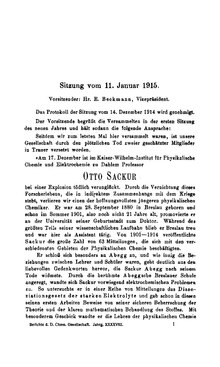Otto Sackur
Otto Sackur (born September 28, 1880 in Breslau , † December 17, 1914 in Berlin ) was a German physical chemist . He was a pioneer in quantum statistics .
Life
Sackur was the son of a factory director and graduated from high school in Breslau. From 1898 he studied chemistry in Heidelberg, Berlin and at the University of Breslau , where he did his doctorate in 1901 under Richard Abegg on the behavior of strong electrolytes. He then worked as an assistant in the chemistry laboratory and in 1902/3 at the Imperial Health Department in Berlin as a scientific assistant. In 1904/5 he spent a few months at the University of London with William Ramsay , where he dealt with radioactivity, and then with Walther Nernst in Berlin. After his habilitation in Breslau, he became a private lecturer in 1905 and titular professor in Breslau in 1911. In 1912 he went to Fritz Haber at the Kaiser Wilhelm Institute for Physical Chemistry and Electrochemistry in Dahlem, where he became department head in 1913. Sackur was killed on December 17, 1914 in an explosion in Haber's laboratory, where he was involved in secret research into explosives and poison gases that were important for the war effort.
plant
Sackur worked both experimentally and theoretically. He researched current publications and reported on them in the Chemisches Zentralblatt . At the same time as Hugo Tetrode (around 1912) he developed the Sackur-Tetrode equation for calculating the entropy of monatomic ideal gases according to classical statistical mechanics . When adapting his formula to the measurement data for mercury vapor, he made the important discovery in 1913 that exactly Planck's constant h must be selected for the "size of the phase space cell" for each of the three coordinates in order to achieve agreement with the data. In the context of the classical method, the phase space cell was nothing but a necessary mathematical trick to be able to make statistical calculations. For this reason, their size at the end of the calculation was reduced to zero if possible, or attempts were made to largely remove them from the results. Max Planck called Sackur's knowledge “of fundamental importance for the whole of thermodynamics”.
Fonts
- Textbook of thermochemistry and thermodynamics , 1912, 2nd edition (edited by Clara von Simson) Springer 1928
- Chemical affinity and its measurement , Vieweg 1908
- with Richard Abegg physical-chemical arithmetic problems , Göschen Collection 1914
literature
- Alexander Kipnis: Sackur, Otto. In: New German Biography (NDB). Volume 22, Duncker & Humblot, Berlin 2005, ISBN 3-428-11203-2 , p. 344 ( digitized version ).
- Massimiliano Badino, Bretislav Friedrich: Much Polyphony but Little Harmony: Otto Sackur's Groping for a Quantum Theory of Gases , in: Physics in Perspective, September 2013, Volume 15, Issue 3, pp 295-319.
Individual evidence
- ↑ Sackur The application of the kinetic theory of gases to chemical problems , Annalen der Physik, Volume 36, 1911, pp. 958-890
- ↑ Sackur The importance of the elementary quantum of action for gas theory and the calculation of chemical constants , in Wilhelm Knapp (ed.): Festschrift Walter Nernst, Halle, 1912, pp. 405-423
- ↑ Sackur, Otto: The universal meaning of the so-called elementary quantum of action , Annalen der Physik Vol. 345: 67-86 (1913).
- ↑ Max Planck: The current importance of the quantum hypothesis for the kinetic gas theory , Phys. Magazine Vol. 14 (1913) p. 258.
Web links
- Literature by and about Otto Sackur in the catalog of the German National Library
| personal data | |
|---|---|
| SURNAME | Sackur, Otto |
| BRIEF DESCRIPTION | German physicist and chemist |
| DATE OF BIRTH | September 28, 1880 |
| PLACE OF BIRTH | Wroclaw |
| DATE OF DEATH | December 17, 1914 |
| Place of death | Berlin |
